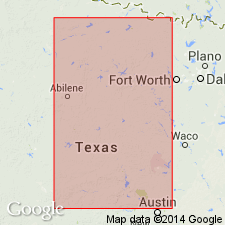
- Usage in publication:
-
- Kickapoo Creek group
- Modifications:
-
- Original reference
- AAPG geologic province:
-
- Fort Worth syncline
- Strawn basin
Summary:
Pg. 209-210. Kickapoo Creek group. Proposed for section between Millsap Lake group (restricted) and Bend group; that is, from disconformity at or near top of Dennis Bridge limestone down to top of Smithwick. Upper 200 feet of group crops out between villages of Dennis and Lipan, but for the most part group must be studied from well samples. Well data indicate that approximately 2,800 feet of section should be assigned to group in southwestern Parker County, north-central Texas, and 3,500 feet or more in Fort Worth basin. Stratigraphic section assigned to group includes Rayville (new), Parks, and Caddo Pool formations which extend from depths 380 to 1,350 feet, 1,350 to 2,125 feet, and 2,125 to 3,000 feet, respectively, in type wells. Kickapoo Creek group proposed in preference to elevation of Parks formation to group status as suggested in 1945. Age is Pennsylvanian (Lampassas). [Some reports place Kickapoo Creek group in Strawn Series.]
Type section (subsurface): logs of Gilbert No. 1 and Wheeler No. 1 wells of southeastern Parker Co., north-central TX, 5 mi northeast of Lipan. Name derived from Kickapoo Creek of southwestern Parker and northwestern Hood Cos., north-central TX.
Source: US geologic names lexicon (USGS Bull. 1200, p. 2005-2006).
For more information, please contact Nancy Stamm, Geologic Names Committee Secretary.
Asterisk (*) indicates published by U.S. Geological Survey authors.
"No current usage" (†) implies that a name has been abandoned or has fallen into disuse. Former usage and, if known, replacement name given in parentheses ( ).
Slash (/) indicates name conflicts with nomenclatural guidelines (CSN, 1933; ACSN, 1961, 1970; NACSN, 1983, 2005, 2021). May be explained within brackets ([ ]).

